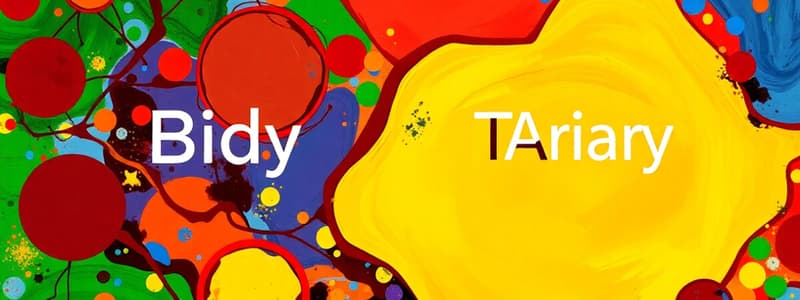Podcast
Questions and Answers
What distinguishes binary acids from other types of acids?
What distinguishes binary acids from other types of acids?
- They must have a hydroxyl group.
- They consist of two elements, neither of which is oxygen. (correct)
- They contain only one type of element.
- They form from organic acids.
Which of the following acids is derived from a polyatomic ion ending in 'ite'?
Which of the following acids is derived from a polyatomic ion ending in 'ite'?
- Nitrous Acid (correct)
- Acetic Acid
- Hydrochloric Acid
- Sulfuric Acid
Which property is characteristic of molecular compounds?
Which property is characteristic of molecular compounds?
- They typically have high boiling points.
- They conduct electricity well.
- They are usually gases or liquids at room temperature. (correct)
- They are formed from ionic bonds.
What is the role of hydrogen ions in acids?
What is the role of hydrogen ions in acids?
What defines the molecular geometry of a compound?
What defines the molecular geometry of a compound?
Which of the following statements about covalent bonding is true?
Which of the following statements about covalent bonding is true?
In water, why do H-O bonds exhibit polarity?
In water, why do H-O bonds exhibit polarity?
Which of the following acids has a molecular formula indicating it comes from a polyatomic ion with an 'ate' ending?
Which of the following acids has a molecular formula indicating it comes from a polyatomic ion with an 'ate' ending?
What is the bond angle in a tetrahedral molecular shape?
What is the bond angle in a tetrahedral molecular shape?
Which naming system is used for covalent compounds?
Which naming system is used for covalent compounds?
What is the correct name for CO2?
What is the correct name for CO2?
Which of the following is a characteristic property of molecular compounds?
Which of the following is a characteristic property of molecular compounds?
In covalent bonding, how do non-metals achieve a full valence shell?
In covalent bonding, how do non-metals achieve a full valence shell?
What prefix would you use for the compound with 4 atoms of an element?
What prefix would you use for the compound with 4 atoms of an element?
What is the name of the compound Si2S3?
What is the name of the compound Si2S3?
Which of the following compounds is named using the acid naming system?
Which of the following compounds is named using the acid naming system?
What would be the correct name for Cl2O8?
What would be the correct name for Cl2O8?
Which scenario best describes a polar covalent bond's effect?
Which scenario best describes a polar covalent bond's effect?
What is the prefix for 10 atoms in a compound?
What is the prefix for 10 atoms in a compound?
What is the primary difference between ionic and covalent naming systems?
What is the primary difference between ionic and covalent naming systems?
Which compound is correctly classified as covalent?
Which compound is correctly classified as covalent?
For the compound H3PO4, what is its class?
For the compound H3PO4, what is its class?
Flashcards
Acid
Acid
A covalent compound containing hydrogen ions that dissociate in water, releasing hydrogen cations (H+) and an anion.
Binary acid
Binary acid
Covalent compounds containing only two elements, one being hydrogen and the other a nonmetal.
"ic" acids
"ic" acids
Acids formed from polyatomic ions ending in 'ate'. Their names end in 'ic'.
"ous" acids
"ous" acids
Signup and view all the flashcards
Covalent/Molecular Compound
Covalent/Molecular Compound
Signup and view all the flashcards
Covalent Bonding
Covalent Bonding
Signup and view all the flashcards
Electronegativity
Electronegativity
Signup and view all the flashcards
Molecular Geometry
Molecular Geometry
Signup and view all the flashcards
Molecular Compound Prefixes
Molecular Compound Prefixes
Signup and view all the flashcards
Tetrahedral
Tetrahedral
Signup and view all the flashcards
Polarity
Polarity
Signup and view all the flashcards
Intermolecular Forces
Intermolecular Forces
Signup and view all the flashcards
Ionic Compound
Ionic Compound
Signup and view all the flashcards
Covalent Naming
Covalent Naming
Signup and view all the flashcards
Acid Naming
Acid Naming
Signup and view all the flashcards
Polyatomic Ion
Polyatomic Ion
Signup and view all the flashcards
Transition Metal
Transition Metal
Signup and view all the flashcards
Chemical Compound Naming
Chemical Compound Naming
Signup and view all the flashcards
Study Notes
Acids
- Acids are covalent compounds that ionize in water.
- They contain hydrogen ions (H⁺) that dissociate in water.
- The general formula for an acid's ionization is: Acid → H⁺ + anion
- Hydrogen ions are responsible for the acidic properties.
Binary Acids
- Contain only two elements (no oxygen).
- Names begin with "hydro" and end with "-ic" acid.
- Example: HCl (Hydrochloric acid)
Tertiary Acids
- Contain three or more elements, including oxygen.
- Two types:
- "ic" acids: derived from polyatomic anions with "-ate" endings. Example: H₂SO₄ (Sulfuric acid), derived from the sulfate ion (SO₄²⁻).
- "ous" acids: derived from polyatomic anions with "-ite" endings. Example: H₂SO₃ (Sulfurous acid), derived from the sulfite ion (SO₃²⁻).
Important Examples of Acids
- Nitric acid (HNO₃): derived from nitrate ion (NO₃⁻)
- Nitrous acid (HNO₂): derived from nitrite ion (NO₂⁻)
- Acetic acid (CH₃COOH or HC₂H₃O₂): derived from acetate ion (C₂H₃O₂⁻)
- Phosphoric acid (H₃PO₄): derived from phosphate ion (PO₄³⁻)
- Phosphorous acid (H₃PO₃): derived from phosphite ion (PO₃³⁻)
- Carbonic acid (H₂CO₃): derived from carbonate ion (CO₃²⁻)
Molecular Compounds
- Made of two or more nonmetal elements.
- Often exist as molecules.
- Examples: H₂O, CO₂, H₂SO₄, CH₄
Properties of Molecular Compounds
- Typically have low melting and boiling points.
- Generally exist as liquids or gases at room temperature.
- Atoms share electrons to achieve a full valence shell (no ions involved).
Covalent Bonding
- Atoms share electrons to achieve a full valence shell.
- The sharing of electrons forms the covalent bond.
Electronegativity
- A measure of an element's ability to attract electrons in a chemical bond.
- Atoms of the same element share electrons equally (non-polar bonds).
- Atoms of different elements share electrons unequally (polar bonds).
- The element with higher electronegativity attracts electrons more strongly, creating partial charges in the bond.
Polar Bonds and Water
- Water's polar O-H bonds contribute to its unique properties (e.g., expansion upon freezing, high boiling point).
Molecular Geometry
- Electron pairs arrange themselves around a central atom to maximize distance.
- The basic shape is a tetrahedron (central atom with 4 electron pairs).
- Lone electron pairs affect the shape of molecules.
Naming Chemical Compounds
- Ionic compounds: Metal-nonmetal (ide)
- Ionic compounds: Metal-polyatomic ion
- Ionic compounds: Transition metal (Roman numeral) nonmetal or polyatomic ion
- Covalent compounds: Use prefix system (e.g., mono-, di-, tri-, etc.) to indicate the number of atoms of each element. Use "ide" ending for second element. Omit "mono-" if only one atom of the first element.
- Acids: If starts with hydrogen, determine if it is a binary acid (hydro- + base name + -ic acid) or a ternary acid (base name + -ic or -ous acid depending on the anion ending with "-ate" or "-ite").
###Naming Covalent Compounds(Examples)
- Cl₂O₈: Dichlorine octoxide
- Si₃N₄: Trisilicon tetranitride
- CO: Carbon monoxide
Distinguishing Between Ionic and Covalent Compounds
- Use the rules and examples to identify whether a compound is ionic or covalent from its formula. Understand the differences in their structure and bonding to accurately classify.
Studying That Suits You
Use AI to generate personalized quizzes and flashcards to suit your learning preferences.



